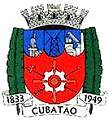HISTÓRIAS E LENDAS DE CUBATÃO - VILA SOCÓ - (13)
A tragédia, em jornais de todo o mundo


Uma das maiores tragédias de Cubatão, senão a maior, foi o incêndio de um oleoduto da Petrobrás que passava sob uma favela, Vila Socó, destruída pelas chamas
com a morte de cerca de uma centena de pessoas, em 24/2/1984. O fato foi destacado em publicações de todo o mundo (acessos em 21/2/2014):
 Jornal The Camberra Times, da Austrália, na
segunda-feira, 27 de fevereiro de 1984, página 5: Jornal The Camberra Times, da Austrália, na
segunda-feira, 27 de fevereiro de 1984, página 5:
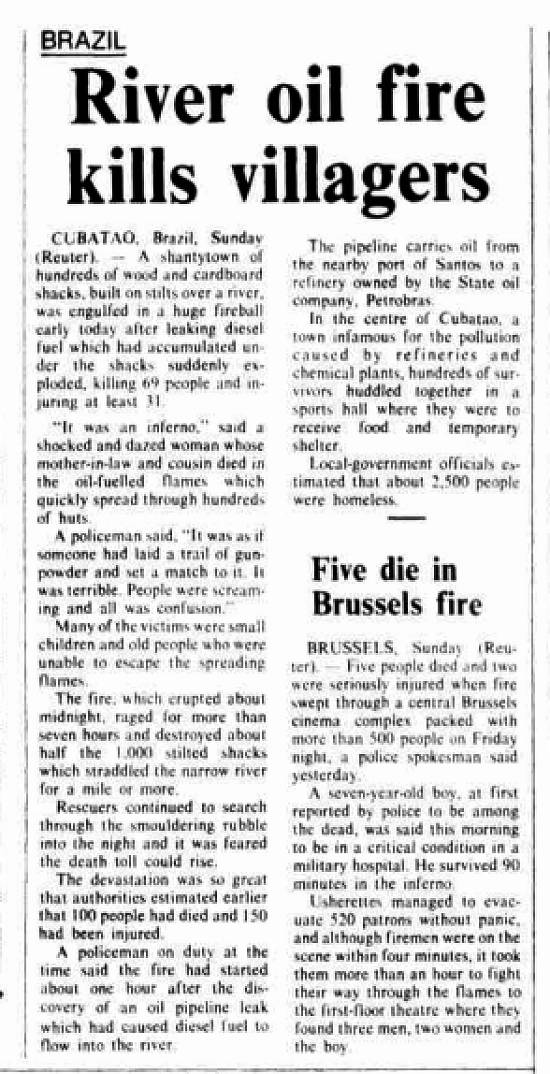
Detalhe da página 5 do jornal australiano The Camberra Times de 27 de fevereiro de 1984
Clique >>aqui<< ou na imagem acima para obter o arquivo PDF correspondente
BRAZIL
River oil fire kills villagers
CUBATAO, Brazil, Sunday (Reuter). - A shantytown of hundreds of wood and cardboard shacks, built on stilts over a river, was engulfed in a huge fireball early today after leaking diesel fuel
which had accumulated under the shacks suddenly exploded, killing 69 people and injuring at least 31.
"It was an inferno," said a shocked and dazed woman whose mother-in-law and cousin died in the oil-fuelled flames which quickly spread through hundreds of huts.
A policeman said, "It was as if someone had laid a trail of gun powder and set a match to it. It was terrible. People were screaming and all was confusion."
Many of the victims were small children and old people who were unable to escape the spreading flames.
The fire, which erupted about midnight, raged for more than seven hours and destroyed about half the 1,000 stilted shacks which straddled the narrow river for a mile or more.
Rescuers continued to search through the smouldering rubble into the night and it was feared the death toll could rise.
The devastation was so great that authorities estimated earlier that 100 people had died and 150 had been injured.
A policeman on duty at the time said the fire had started about one hour after the discovery of an oil pipeline leak which had caused diesel fuel to flow into the river.
The pipeline carries oil from the nearby port of Santos to a refinery owned by the State oil company, Petrobras.
In the centre of Cubatao, a town infamous for the pollution caused by refineries and chemical plants, hundreds of survivors huddled together in a sports hall where they were to receive food and temporary shelter.
Local-government officials es timated that about 2,500 people were homeless. |
| Jornal The Camberra Times, da Austrália, na terça-feira, 28 de fevereiro de 1984,
página 4:
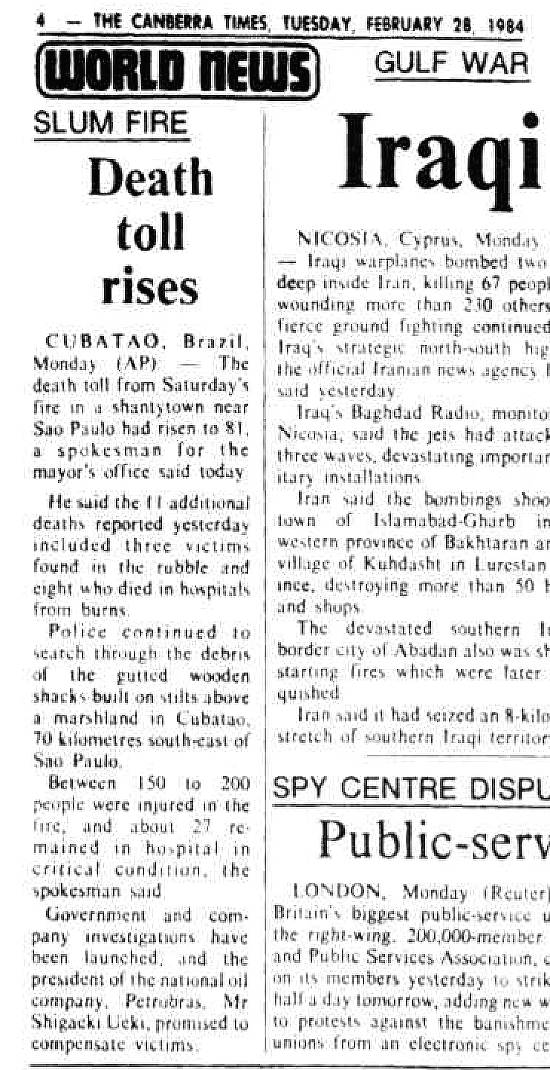
Detalhe da página 4 do jornal australiano The Camberra Times de 28 de fevereiro de 1984
Clique >>aqui<< ou na imagem acima para obter o arquivo PDF correspondente
SLUM FIRE
Death toll rises
CUBATAO, Brazil, Monday (AP). - The death toll from Saturday's fire in a shantytown near Sao Paulo had risen to 81, a spokesman for the mayor's office said today.
He said the 11 additional deaths reported yesterday included three victims found in the rubble and eight who died in hospitals from burns.
Police continued to search through the debris of the gutted wooden shacks built on stilts above a marshland in Cubatao, 70 kilometres south-east of Sao Paulo.
Between 150 to 200 people were injured in the fire, and about 27 remained in hospital in critical condition, the spokesman said.
Government and company investigations have been launched, and the president of the national oil company, Petrobras, Mr. Shigaeki Ueki, promised to compensate victims. |
Em Barcelona, na Espanha, o jornal La Vanguardia registrava na edição de 26 de fevereiro de 1984, página 24 (acesso em 21/2/2014):
 Jornal La Vanguardia, de Barcelona, Espanha, no domingo, 26 de fevereiro de 1984 -
página 24:
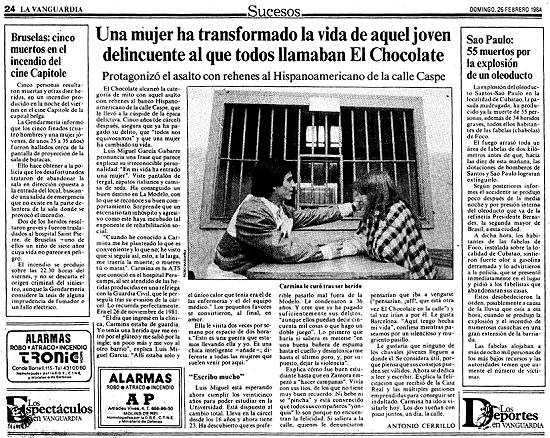
Página 24 do jornal espanhol La Vanguardia de Barcelona, de 26 de fevereiro de 1984
Clique >>aqui<< ou na imagem acima para obter o arquivo PDF correspondente
Sao Paulo: 55 muertos por la explosión de un oleoducto
La explosión del oleoducto Santos-Sao Paulo en la localidad de Cubatao, la pasada madrugada, ha producido ya la muerte de 55 personas, además de 34 heridos graves, todos ellos habitantes de las
fabelas (chabolas) de Foco.
El fuego arrasó toda un área de fabelas de dos kilómetros antes de que, hacia las diez de esta mañana, las dotaciones de bomberos de Santos y Sao Paulo lograran extinguirlo.
Según posteriores informes el accidente se produjo poco después de la media noche y por presión interna del oleoducto que va de la refinería Presidente Bernades, la segunda mayor de Brasil, a esta ciudad.
A dicha hora, los habitantes de las fabelas de Foco, instalada sobre la localidad de Cubatao, sintieron fuerte olor a gasolina derramada y lo advirtieron a la policía. que se presentó inmediatamente en el lugar y pidió a los fabelistas que
abandonaran sus casas.
Estos desobedecieron la orden. posiblemente a causa de la lluvia que caía a esa hora, cuando se produjo la explosión y el incendio de numerosas casuchas en una gran extensión de la batriada;
Las fabelas alojaban a más de ocho mil personas de los más bajos recursos y las autoridades temen que aumente el número de víctimas. |
| Jornal La Vanguardia, de Barcelona, Espanha, na segunda-feira, 26 de março de 1984 -
página 18: 
Detalhe da página 18 do jornal espanhol La Vanguardia de Barcelona, de 26 de março de 1984
Clique >>aqui<< ou na imagem acima para obter o arquivo PDF correspondente
Brasil: el incendio de un oleoducto causó 508 muertes
Sao Paulo. (DPA.). - Por lo menos 508 personas debieron haber perdido la vida en el incendio de un barrio de 'favelas' (barracas) en la ciudad industrial de Cubatao, causado por la explosión de un oleoducto,
según denunció el fiscal Marcos Ribeiro de Freitas, quien sigue las investigaciones sobre la tragedia, ocurrida en febrero pasado.
Según las informaciones oficiales dadas a conocer después del incendio, el número de muertos sería de 86, pero el fiscal Ribeiro de Freitas recordó que los demás cadáveres — en su mayoría niños — no fueron contabilizados "porque se han vuelto
cenizas".
Añadió Ribeiro de Freitas que dentro de dos semanas elevará una denuncia a la Magistratura de la ciudad porteña de Santos, haciendo acusaciones individuales por responsabilidad en el incendio.
Según el fiscal, su estimación de que el número de muertos supera a 500 se basa en el número de niños con matrícula en la escuela del barrio de 'favelas' de Vila Soco: de los 305 niños que estudiaban en esa escuela, sólo 60 fueron ubicados, lo que
lleva a creer que existen 245 niños desaparecidos.
"Teniendo corno base un número conservador, uno puede estimar que la mitad de esos 245 niños, es decir, 122, están muertos. Además, considerando que hubo 450 casas destruidas y un promedio de un niño para cada uno, podemos estimar que más de 500
personas fueron víctimas de la tragedia", dijo Ribeiro de Freitas.
El fiscal declinó revelar quién será responsabilizado por la tragedia, pero admitió que se trata de funcionanos del ente estatal Petrobras. |
Outras publicações internacionais também registraram o evento (acessos em 21/2/2014):
| Time Magazine, de Tampa, Florida/EUA, segunda-feira, 9 de abril de 1984: 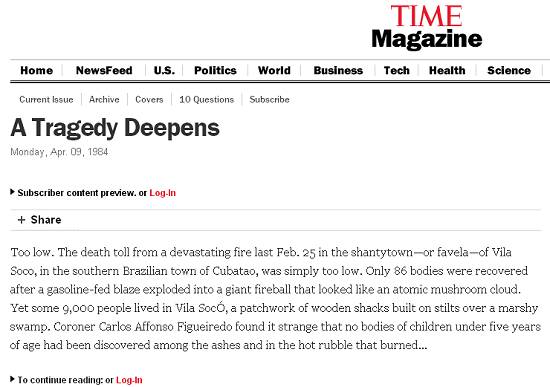
Trecho inicial da matéria, disponibilizado na Internet pela publicação
A Tragedy Deepens
Monday, Apr. 09, 1984
Too low. The death toll from a devastating fire last Feb. 25 in the shantytown—or favela—of Vila Soco, in the southern Brazilian town of Cubatao, was simply too low. Only 86 bodies were recovered
after a gasoline-fed blaze exploded into a giant fireball that looked like an atomic mushroom cloud. Yet some 9,000 people lived in Vila Socó, a patchwork of wooden shacks built on stilts over a marshy swamp. Coroner Carlos Affonso Figueiredo found
it strange that no bodies of children under five years of age had been discovered among the ashes and in the hot rubble that burned... |
|
Le Monde, de Paris (França), 28 de
fevereiro de 1984: 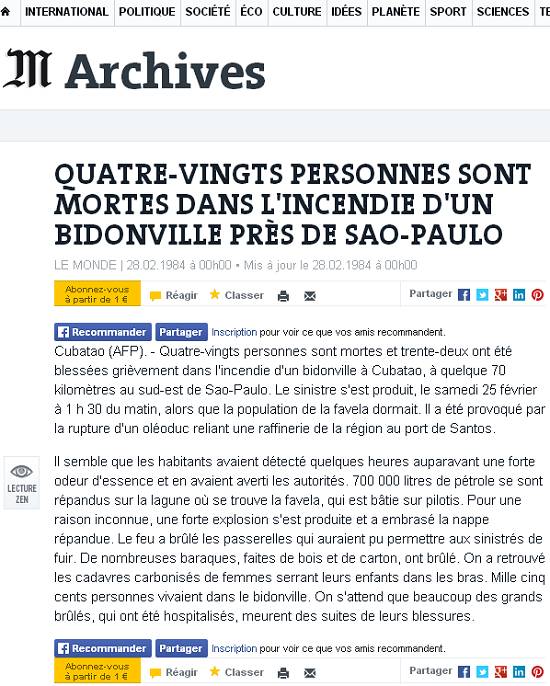
Trecho inicial da matéria, disponibilizado na Internet pela publicação
QUATRE-VINGTS PERSONNES SONT MORTES DANS L'INCENDIE D'UN BIDONVILLE PRÈS DE SAO-PAULO
LE MONDE | 28.02.1984 à 00h00 • Mis à jour le 28.02.1984 à 00h00
Cubatao (AFP). - Quatre-vingts personnes sont mortes et trente-deux ont été blessées grièvement dans l'incendie d'un bidonville à Cubatao, à quelque 70 kilomètres au sud-est de Sao-Paulo. Le sinistre s'est
produit, le samedi 25 février à 1 h 30 du matin, alors que la population de la favela dormait. Il a été provoqué par la rupture d'un oléoduc reliant une raffinerie de la région au port de Santos.
Il semble que les habitants avaient détecté quelques heures auparavant une forte odeur d'essence et en avaient averti les autorités. 700 000 litres de pétrole se sont répandus sur la lagune où se trouve la favela, qui est bâtie sur pilotis. Pour
une raison inconnue, une forte explosion s'est produite et a embrasé la nappe répandue. Le feu a brûlé les passerelles qui auraient pu permettre aux sinistrés de fuir. De nombreuses baraques, faites de bois et de carton, ont brûlé. On a retrouvé
les cadavres carbonisés de femmes serrant leurs enfants dans les bras. Mille cinq cents personnes vivaient dans le bidonville. On s'attend que beaucoup des grands brûlés, qui ont été hospitalisés, meurent des suites de leurs blessures. |
| The New York Times, de New York/EUA, 26 de
fevereiro de 1984: 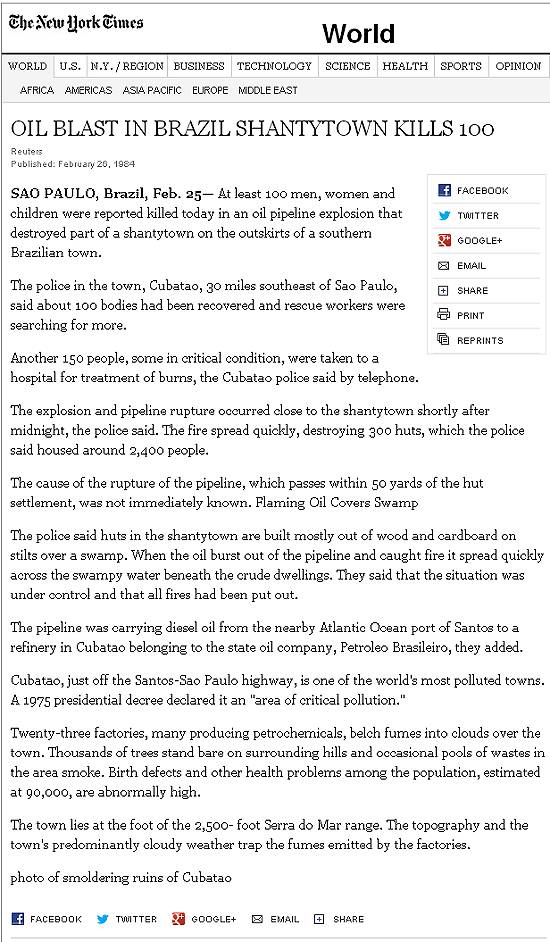
Texto da matéria, disponibilizado na Internet pela publicação
OIL BLAST IN BRAZIL SHANTYTOWN KILLS 100
Reuters
Published: February 26, 1984
SAO PAULO, Brazil, Feb. 25— At least 100 men, women and children were reported killed today in an oil pipeline explosion that destroyed part of a shantytown on the outskirts of a southern Brazilian town.
The police in the town, Cubatao, 30 miles southeast of Sao Paulo, said about 100 bodies had been recovered and rescue workers were searching for more.
Another 150 people, some in critical condition, were taken to a hospital for treatment of burns, the Cubatao police said by telephone.
The explosion and pipeline rupture occurred close to the shantytown shortly after midnight, the police said. The fire spread quickly, destroying 300 huts, which the police said housed around 2,400 people.
The cause of the rupture of the pipeline, which passes within 50 yards of the hut settlement, was not immediately known. Flaming Oil Covers Swamp
The police said huts in the shantytown are built mostly out of wood and cardboard on stilts over a swamp. When the oil burst out of the pipeline and caught fire it spread quickly across the swampy water beneath the crude dwellings. They said that
the situation was under control and that all fires had been put out.
The pipeline was carrying diesel oil from the nearby Atlantic Ocean port of Santos to a refinery in Cubatao belonging to the state oil company, Petroleo Brasileiro, they added.
Cubatao, just off the Santos-Sao Paulo highway, is one of the world's most polluted towns. A 1975 presidential decree declared it an ''area of critical pollution.''
Twenty-three factories, many producing petrochemicals, belch fumes into clouds over the town. Thousands of trees stand bare on surrounding hills and occasional pools of wastes in the area smoke. Birth defects and other health problems among the
population, estimated at 90,000, are abnormally high.
The town lies at the foot of the 2,500- foot Serra do Mar range. The topography and the town's predominantly cloudy weather trap the fumes emitted by the factories.
photo of smoldering ruins of Cubatao |
| The New York Times, de New York/EUA, 26 de março de 1984: 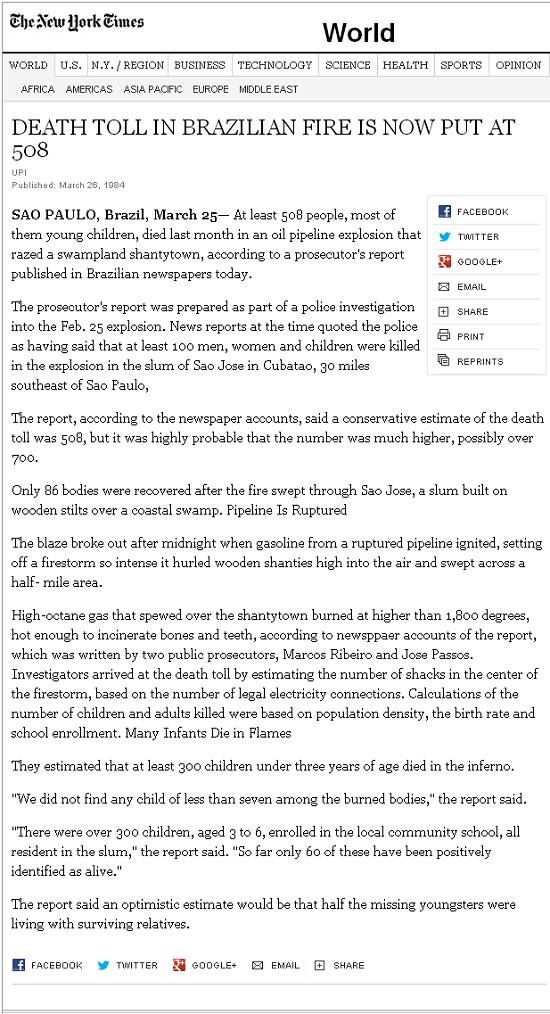
Texto da matéria, disponibilizado na Internet pela publicação
DEATH TOLL IN BRAZILIAN FIRE IS NOW PUT AT 508
UPI
Published: March 26, 1984
SAO PAULO, Brazil, March 25 — At least 508 people, most of them young children, died last month in an oil pipeline explosion that razed a swampland shantytown, according to a prosecutor's report published in
Brazilian newspapers today.
The prosecutor's report was prepared as part of a police investigation into the Feb. 25 explosion. News reports at the time quoted the police as having said that at least 100 men, women and children were killed in the explosion in the slum of Sao
Jose in Cubatao, 30 miles southeast of Sao Paulo,
The report, according to the newspaper accounts, said a conservative estimate of the death toll was 508, but it was highly probable that the number was much higher, possibly over 700.
Only 86 bodies were recovered after the fire swept through Sao Jose, a slum built on wooden stilts over a coastal swamp. Pipeline Is Ruptured
The blaze broke out after midnight when gasoline from a ruptured pipeline ignited, setting off a firestorm so intense it hurled wooden shanties high into the air and swept across a half- mile area.
High-octane gas that spewed over the shantytown burned at higher than 1,800 degrees, hot enough to incinerate bones and teeth, according to newsppaer accounts of the report, which was written by two public prosecutors, Marcos Ribeiro and Jose
Passos. Investigators arrived at the death toll by estimating the number of shacks in the center of the firestorm, based on the number of legal electricity connections. Calculations of the number of children and adults killed were based on
population density, the birth rate and school enrollment. Many Infants Die in Flames
They estimated that at least 300 children under three years of age died in the inferno.
''We did not find any child of less than seven among the burned bodies,'' the report said.
''There were over 300 children, aged 3 to 6, enrolled in the local community school, all resident in the slum,'' the report said. ''So far only 60 of these have been positively identified as alive.''
The report said an optimistic estimate would be that half the missing youngsters were living with surviving relatives. |

|
